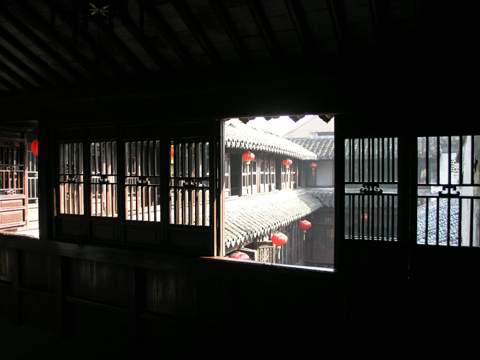







































































































































































































































| | 
|
Located in Kunshan city about 25 kilometers east of Suzhou, Luzhi is an old but extremely beautiful water town. With a history of more than 1400 years, it compares favorably to Zhouzhuang Town. Covering just one square kilometer, it has been awarded the great name of 'the first water town in China'.
The natural beauty of the town is indescribable. Old stone bridges, limpid water, venerable maidenhair trees and old-style dwellings, as well as the traditional women's costumes, create an ideal 'civilized, rich, pastoral and harmonious' environment. Many travellers from all over the world enjoy the peace and tranquillity. In addition, Luzhi town is noted for several historical and cultural relics, such as Baosheng temple, the Wansheng Rice Company and the White Lotus Flower Temple of the North Song Dynasty.
Bridges: The town's most notable features are its numerous quaint stone bridges, which were built in the Song, Yuan, Ming and Qing Dynasties. Owing to that, Luzhi deserves its reputation as a 'Museum of Chinese Ancient Bridges.' At one time, there were 72 bridges in the tiny town; 41 still exist and are well preserved. All of the bridges are different in design and style, but two are considered especially noteworthy.
Zhengyang Bridge: Built in the Wanli era of the Ming Dynasty (1368-1644), Zhengyang Bridge is the biggest stone arch bridge in Luzhi town. It is known for being the first to receive sunshine in the early morning. Moreover, this old bridge is a vantage point for viewing the whole fascinating landscape of the water town.
Dongmei Bridge: Located on the eastern side of town, Dongmei Bridge is most famous for its unique structure and many Buddhist designs, which are listed in the history of Chinese bridges. It is a completely round bridge, half of which rests above the surface of the water and half of which lies below. The combination of Buddhist engravings and unique circular design makes this a very rare bridge that is definitely worth visiting.
Baosheng Temple: Built in 503, Baosheng Temple is a must-see historical site in Luzhi. This old temple has a history of more than 1500 years. Its nine famous clay arhats were sculptured in the Tang Dynasty and are still well preserved. Such arhats are not only rare in the region south of the Yangtze River but unique in the country. In addition, the temple boasts treasures from different dynasties, including a Buddhist stone pillar from the Tang Dynasty (618-907), a stone flagpole from the North Song Dynasty (960-1279), a hall built during the Ming Dynasty (1368-1644) and an iron bell from the Qing Dynasty (1644-1911).
Xiao House: Xiao House is the most integrated, well-preserved architecture dating back to the Qing Dynasty (1644-1911). Situated on Shangtang Street, Xiao House was built in 1889 and represents a typical southeast China house of a rich family of 19th century. Covering an area of over 1,000 square meters, the house is composed of dozens of rooms with a private lane named Xiao Lane. Visiting the house, you can relive the previous tenants' elegant style of life.
Wansheng Rice Shop: Built in 1910, Wansheng Rice Store is an old-established rice shop that was once operated by two wealthy businessmen and now serves as the rice distribution centre for Luzhi and nearby towns. Many quaint antique agricultural tools are displayed for travellers to view.
Another feature of the town is the distinctive traditional costume worn by the women. Both clothes and trousers are characteristically pieced together using different cotton materials in a variety of designs. In addition to wearing these interesting clothes, local women are accustomed to wearing colorful kerchiefs and embroidered shoes. Undoubtedly, these lovely local women wearing traditional Luzhi-style costumes add freshness and loveliness to the water town, like a beautiful landscape picture.
Luzhi is truly a peaceful and pristine land. Beautiful water, elegant stone bridges, and lovely women will take you into a fascinating world - one which you may enjoy so much that you forget to go home.
| |
  |
|
|















